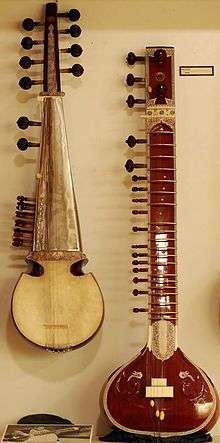Bansuri
A bansuri is a side blown flute originating from the Indian subcontinent. It is an aerophone produced from bamboo, used in Hindustani classical music. It is referred to as nadi and tunava in the Rigveda and other Vedic texts of Hinduism.[1][2] Its importance and operation is discussed in the Sanskrit text Natya Shastra.[3][4][5]
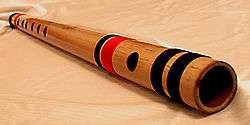 A 23-inch-long bansuri bamboo flute for concerts. | |
| Other names | Baanhi, Baashi, Bansi, Basari, Murali |
|---|---|
| Classification | woodwind instrument |
| Playing range | |
| 2.5 octaves (six-hole), 3 octaves (seven-hole) | |
| Musicians | |
| List of Indian flautists | |
A bansuri is traditionally made from a single hollow shaft of bamboo with six or seven finger holes. Some modern designs come in ivory, fiberglass and various metals. The six hole instrument covers two and a half octaves of music. The bansuri is typically between 30 centimetres (12 in) and 75 centimetres (30 in) in length, and the thickness of a human thumb.[6][7] One end is closed, and few centimeters from the closed end is its blow hole. Longer bansuris feature deeper tones and lower pitches.[6] The traditional design features no mechanical keys, and the musician creates the notes he wants by tapping the various finger holes.[6][8]
The bansuri-like flute is depicted in ancient Buddhist,[9] Hindu[10] and Jain temple paintings and reliefs, and is common in the iconography of the Hindu god Krishna.[11][12] it is intimately linked to the love story of Krishna and Radha.[13] The bansuri is revered as Lord Krishna's divine instrument and is often associated with Krishna's Rasa lila dance. These legends sometimes use alternate names for this wind instrument, such as the murali.[14][11] However, the instrument is also common among other traditions such as Shaivism.[15] The early medieval Indian texts also refer to it as vaṃśi, while in medieval Indonesian Hindu and Buddhist arts, as well as temple carvings in Java and Bali dated to be from pre-10th century period, this transverse flute has been called wangsi or bangsi.[16]
Etymology and nomenclature
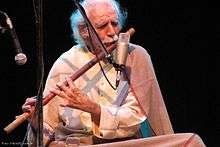
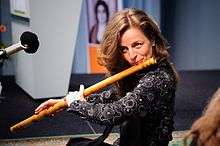
The word bansuri originates in the bans (बाँस) [bamboo] + sur (सुर) [melody].
A phonetically similar name for the same instrument, in early medieval texts, is the Sanskrit word vaṃśi which is derived from root vaṃśa (Sanskrit: वंश[17]) meaning bamboo.[16] A flute player in these medieval texts is called vamsika.[18]
Other regional names of bansuri-style, six to eight play holes, bamboo flutes in India include bansi, eloo, kulal, kulalu, kukhl, lingbufeniam, murali, murli, nadi, nar, pawa, pullankuzhal, pillana grovi, pulangoil, vansi, vasdanda, sipung, and venuvu.[19][20][21] Ancient regional innovations, such as those in the Himalayan foothills of India, developed more complex designs, such as the algoza which is a "twin bansuri" in different keys constructed as a single instrument, allowing the musician to play more complex music. In central and south India, a similar innovation is called nagoza or Template:Mattiyaan jodi, and Buddhist stupa reliefs in central India, from about the 1st century BCE, depict the single and twinned flute designs.[22][23]
History
According to Ardal Powell, flute is a simple instrument found in numerous ancient cultures. According to legends the three birthplaces of flutes are Egypt, Greece, and India. Of these, the transverse flute (side blown) appeared only in ancient India, while the fipple flutes are found in all three. It is likely, states Powell, that the modern Indian bansuri has not changed much since the early medieval era.[20][24] However, a flute of a somewhat different design is evidenced in ancient China (dizi) which Powell, quoting Curt Sachs' The History of Musical Instruments, suggests may not have originated in China but evolved from a more ancient Central Asian flute design. It is, however, not clear whether there was any connection between the Indian and Chinese varieties.[24]
The early medieval Indian bansuri was, however, influential. Its size, style, bindings, mounts on ends and playing style in medieval Europe artworks has led scholars, such as Liane Ehlich, a flute scholar at the music school in the University of Lucerne, to state that the bansuri (venu) migrated from India into the Byzantium Empire by the 10th century and from there on to medieval Europe where it became popular.[24][25]
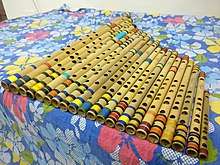
The flute is discussed as an important musical instrument in the Natya Shastra (~200 BCE to 200 CE), the classic Sanskrit text on music and performance arts.[3] The flute (Venu or Vamsa) is mentioned in many Hindu texts on music and singing, as complementary to the human sound and Veena (vaani-veena-venu).[26][27] The flute is however not called bansuri in the ancient, and is referred to by other names such as nadi, tunava in the Rigveda (1500–1200 BCE) and other Vedic texts of Hinduism, or as venu in post-Vedic texts.[1][2][3] The flute is also mentioned in various Upanishads and Yoga texts.[28]
According to Bruno Nettl, a music historian and ethnomusicologist, the ancient surviving sculptures and paintings in the temples and archaeological sites of India predominantly show transverse flutes being played horizontally (with a downward tilt).[29] However, beginning in the 15th century, vertical end blowing style are commonly represented. This change in the relevance and style of bansuri is likely, states Nettl, because of the arrival of Islamic rule era on the Indian subcontinent and the West Asian influence on North Indian music.[30]
Construction
A bansuri is traditionally produced from a special type of bamboo, that naturally grows to long lengths between its nodes (knots). These grow abundantly in Himalayan foothills up to about 11,000 feet with high rainfall. These are particularly found in the northeastern (near Assam, Arunachal Pradesh, Meghalaya, Manipur, Mizoram, Nagaland, Sikkim, Tripura) and Western Ghats (near Kerala) states of India where numerous bamboo species grow with internodal lengths greater than 40 centimetres (16 in).[31][32]
The harvested bamboo with a desired diameter is cut, dried and treated with natural oils and resins to strengthen it. Once ready, the artisans examine the smoothness and straightness and measure the dried hollow tube. They mark the exact positions for the holes, then use hot metal rod skewers of different diameters to burn in the holes. Drilling and other methods of hole making are avoided as it is believed they damage the fiber orientation and the splits affects the music quality. The burnt-in holes are then finished by sanding, one end plugged, the flute ringed at various positions to stabilize its form and shape over time and the unit tested for its musical performance. The distance of a finger-hole from the mouth-hole, and the diameter of the finger-hole controls the note it plays. Adjustments to the diameters of various holes is made by the artisans to achieve purity of the musical notes produced. The wall thickness of the bansuri determines the tone, range and octave tuning. Once all the holes have reached their performance range, the bansuri is steeped in natural oils, cleaned, dried and decorated or bound with silk or nylon threads.[33][34]
There are two varieties of bansuri: transverse and fipple. The fipple flute is usually played in folk music and is held at the lips like a tin whistle. Because the transverse variety enables superior control, variations and embellishments, it is preferred in Indian classical music.
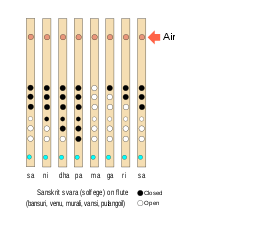
Musical notes
Six holes are sufficient to produce the seven basic swaras: sa, re, ga, ma, pa, dha, and ni. When all holes are closed, it produces the bass scale that is the root note of the bansuri (pa). With one hole farthest from the closed end of the bansuri open, the instrument plays the dha. Similarly, ni is produced with two farthest holes open, sa with three farthest open, ri with four, ga with five, and ma is produced with all holes open.[35]
Every bansuri by its design and construction has a specific key and tonal center, corresponding to sa (shadja, natural tonic) of the swara scale.[36] This key is achieved by variations in length, inner diameter of the instrument and the relative size and placement of the finger holes. This allows the musician to select a bansuri constructed in the key of the music she wants to create and share.[37][38]
Playing
A bansuri is typically held horizontally slanting downwards towards right by the bansuri player. The index, middle and ring fingers of the right hand cover the outer fingerholes, while the same fingers of the left hand cover the rest. The bansuri is supported by the thumb and little finger, while the airhole is positioned near the lips and air blown over it at various speeds to reach the desired octave. For the seven-hole bansuri, the little finger (pinky) of the right hand is usually employed.[39]
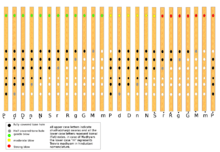
As with other air-reed wind instruments, the sound of a bansuri is generated from resonance of the air column inside it. The length of this column is varied by closing or leaving open, a varying number of holes. Half-holing is employed to play flat or minor notes. The 'sa' (on the Indian sargam scale, or equivalent 'do' on the octave) note is obtained by covering the first three holes from the blowing-hole. Octaves are varied by manipulating one's embouchure and controlling the blowing strength. Either finger tips or finger pads are used by bansuri players to partially or fully cover the tap holes.
In order to play the diatonic scale on a bansuri, one needs to find where the notes lie. For example, in a bansuri where Sa or the tonic is always played by closing the first three holes, is equivalent to C, one can play sheet music by creating a finger notation that corresponds to different notes. A flutist is able to perform complex facets of Raga music such as microtonal inflections, ornamentation, and glissando by varying the breath, performing fast and dextrous fingering, and closing/opening the holes with slow, sweeping gestures.
References
- Arthur Berriedale Keith (1995). Vedic Index of Names and Subjects. Motilal Banarsidass. p. 441. ISBN 978-81-208-1332-8.
- Suneera Kasliwal (2004). Classical musical instruments. Rupa. pp. 85–86. ISBN 978-81-291-0425-0.
- Rowell 2015, pp. 99–103.
- Te Nijenhuis 1974, pp. 30–33.
- Ananda Lal (2004). The Oxford Companion to Indian Theatre. Oxford University Press. p. 311. ISBN 978-0-19-564446-3.
- Ashok Damodar Ranade 2006, pp. 284–286.
- Bettina Bäumer; Kapila Vatsyayan (1988). Kalatattvakosa: A Lexicon of Fundamental Concepts of the Indian Arts. Motilal Banarsidass. p. 181. ISBN 978-81-208-1402-8.
- Dorothea E. Hast; James R. Cowdery; Stanley Arnold Scott (1999). Exploring the World of Music: An Introduction to Music from a World Music Perspective. Kendall Hunt. p. 153. ISBN 978-0-7872-7154-1.
- Patricia E. Karetzky (2000). Early Buddhist Narrative Art: Illustrations of the Life of the Buddha from Central Asia to China, Korea and Japan. University Press of America. pp. 44, 60. ISBN 978-1-4617-4027-8.
- Alice Boner (1990). Principles of Composition in Hindu Sculpture: Cave Temple Period. Motilal Banarsidass. pp. 157–163, 186–187. ISBN 978-81-208-0705-1.
- Pratapaditya Pal; Stephen P. Huyler; John E. Cort; et al. (2016). Puja and Piety: Hindu, Jain, and Buddhist Art from the Indian Subcontinent. Univ of California Press. pp. 37–38, 47–49, 59–60. ISBN 978-0-520-28847-8.
- Martinez 2001, pp. xxvii-xxviii, 325, 342.
- Sorrell & Narayan 1980, pp. 35–36.
- Lochtefeld 2002, p. 370–371, 449.
- Dalal 2014, p. 28, see entry for Shiva-dedicated saint Anaya.
- Jaap Kunst (2013). Hindu-Javanese Musical Instruments. Springer. pp. 25–26. ISBN 978-94-011-9185-2.
- vaMza, Sanskrit-English Dictionary, Koeln University, Germany
- Emmie Te Nijenhuis (1992). Saṅgītaśiromaṇi: A Medieval Handbook of Indian Music. Brill Academic. p. 303. ISBN 90-04-09498-9.
- Nettl et al. 1998, pp. 345, 350–354, 360, 497.
- Peter Westbrook (2003), The bansuri and pulangoil, bamboo flutes of India, Flutist Quarterly, Vol. 28, No. 3, pages 1–4
- Dale A. Olsen (2013). World Flutelore: Folktales, Myths, and Other Stories of Magical Flute Power. University of Illinois Press. pp. 10–12. ISBN 978-0-252-09514-6.
- Alka Pande (1999). Folk Music & Musical Instruments of Punjab. Mapin. pp. 44–46. ISBN 978-1-890206-15-4.
- Nettl et al. 1998, p. 345.
- Ardal Powell (2002). The Flute. Yale University Press. pp. 10–13. ISBN 978-0-300-09498-5.
- Liane Ehlich (1984), Zur Ikonographie der Querflöte im Mittelalter. Basler Jahrbuch für historische Musikpraxis, Volume 8, pages 197–211 (in German)
- Tarla Mehta (1995). Sanskrit Play Production in Ancient India. Motilal Banarsidass. pp. 149–150. ISBN 978-81-208-1057-0.
- Martinez 2001, p. 127.
- Beck 1993, pp. 98–110.
- Nettl et al. 1998, pp. 306 with Figure 1 p. 299.
- Nettl et al. 1998, pp. 306, with Figure 1 p. 299 and Figure 5 p. 304.
- Sir George Watt (1908). The Commercial Products of India. J. Murray. pp. 98–106.
- K. K. Seethalakshmi; M. S. Muktesh Kumar; K. Sankara Pillai; et al. (1998). Bamboos of India: A Compendium. BRILL. pp. 20, 80–83, 123, 184. ISBN 81-86247-25-4.
- Peter Westbrook (2003), The bansuri and pulangoil, bamboo flutes of India, Flutist Quarterly, Vol. 28, No. 3, pages 1–27
- Dale A. Olsen (2013). World Flutelore: Folktales, Myths, and Other Stories of Magical Flute Power. University of Illinois Press. pp. 15–27. ISBN 978-0-252-09514-6.
- Lyon Leifer (2005). How to Play the Bansuri: A Manual for Self-instruction Based on the Teaching of Devendra Murdeshwar. Rasa Music. pp. 1–7. ISBN 978-0-9766219-0-4.
- Ellen Koskoff (2008). The Concise Garland Encyclopedia of World Music: The Middle East, South Asia, East Asia, Southeast Asia. Routledge. p. 980. ISBN 978-0-415-99404-0.
- Mark Shepard (2002). Simple Flutes. Simple. pp. 19–21, 31–35. ISBN 978-0-938497-18-9.
- G Dournon; M Helffer (1984). "Bansuri". In Stanley Sadie (ed.). The New Grove dictionary of musical instruments, Volume 1. Macmillan Press. ISBN 978-0-943818-05-4.
- Leifer, Lyon (2005). How to Play the Bansuri: A Manual for Self-Instruction Based on the Teaching of Devendra Murdeshwar. Rasa Music Co. ISBN 0-9766219-0-8.
Bibliography
- Beck, Guy (1993). Sonic Theology: Hinduism and Sacred Sound. Columbia: University of South Carolina Press. ISBN 978-0-87249-855-6.CS1 maint: ref=harv (link)
- Caudhurī, Vimalakānta Rôya (2000). The Dictionary of Hindustani Classical Music. Motilal Banarsidass. ISBN 978-81-208-1708-1.
- Dalal, Roshen (2014). Hinduism: An Alphabetical Guide. Penguin Books. ISBN 978-81-8475-277-9.CS1 maint: ref=harv (link)
- Daniélou, Alain (1949). Northern Indian Music, Volume 1. Theory & technique; Volume 2. The main rāgǎs. London: C. Johnson. OCLC 851080.
- Gautam, M.R. (1993). Evolution of Raga and Tala in Indian Music. Munshiram Manoharlal. ISBN 81-215-0442-2.
- Kaufmann, Walter (1968). The Ragas of North India. Oxford & Indiana University Press. ISBN 978-0-253-34780-0. OCLC 11369.
- Lochtefeld, James G. (2002). The Illustrated Encyclopedia of Hinduism, 2 Volume Set. The Rosen Publishing Group. ISBN 978-0-8239-2287-1.CS1 maint: ref=harv (link)
- Martinez, José Luiz (2001). Semiosis in Hindustani Music. Motilal Banarsidass. ISBN 978-81-208-1801-9.CS1 maint: ref=harv (link)
- Nettl, Bruno; Ruth M. Stone; James Porter; Timothy Rice (1998), The Garland Encyclopedia of World Music: South Asia : the Indian subcontinent, Routledge, ISBN 978-0-8240-4946-1
- Ashok Damodar Ranade (2006). Music Contexts: A Concise Dictionary of Hindustani Music. Bibliophile South Asia. ISBN 978-81-85002-63-7.CS1 maint: ref=harv (link)
- Randel, Don Michael (2003). The Harvard Dictionary of Music (fourth ed.). Cambridge, MA: Harvard University Press. ISBN 978-0-674-01163-2.
- Rowell, Lewis (2015). Music and Musical Thought in Early India. University of Chicago Press. ISBN 978-0-226-73034-9.CS1 maint: ref=harv (link)
- Sorrell, Neil; Narayan, Ram (1980). Indian Music in Performance: A Practical Introduction. Manchester University Press. ISBN 978-0-7190-0756-9.CS1 maint: ref=harv (link)
- Te Nijenhuis, Emmie (1974). Indian Music: History and Structure. BRILL Academic. ISBN 90-04-03978-3.CS1 maint: ref=harv (link)
- Wilke, Annette; Moebus, Oliver (2011). Sound and Communication: An Aesthetic Cultural History of Sanskrit Hinduism. Walter de Gruyter. ISBN 978-3-11-024003-0.
